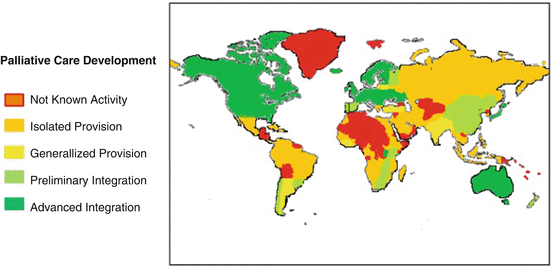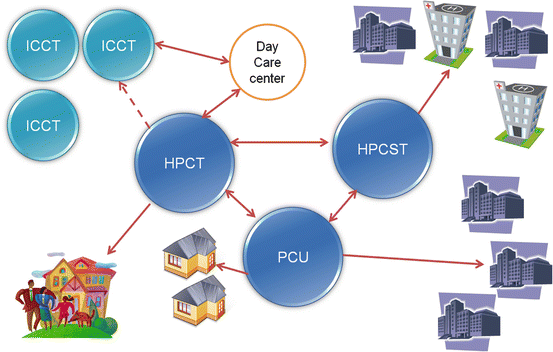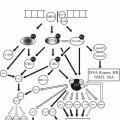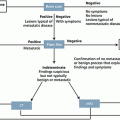Fig. 42.1
Levels of differentiation of palliative care
In a total sense of the response to these levels of differentiation of care, the basic requests required are the professional’s training, the advanced planning, the continuity and availability of these types of care as well as the attention for the relative preference to the local where the patient wants to be cared [41, 42].
In concrete, when it comes to services of palliative care that are specialized, these are developing all over the world. Initially focused to the oncology patients, but nowadays they are also for other terminal illnesses [43].
Looking to give answers to the desires and patients’ preferences, relatively to the local where they’d like to receive care and where they’d prefer to die, it is necessary various ways of typologies of specialized resources, organized under a network of palliative care . These typologies can be under the form of unity of palliative care, hospital team of support in palliative care, palliative care team of household and day centers [41].
An Palliative Care Unit (PCU) gives care to hospitalized patients, being that a service who is specifically destined to treat and care of the palliative patient, being able to be on a acute patients’ hospital, non-acute patients, on a ward on the inside or an adjacent structure to that hospital. It can be completely autonomous of an hospital’s structure. It should always work in a perspective of an early discharge with transference to another typology of care, unless it is dedicated to an unity like an hospice, where the patient will remain, if he desires or if he has to, until he dies. It is estimated that this need of typology of resources in 80–100 beds per million of habitants, being that each unity must have rather 8–12 beds [41].
The Hospital Palliative Care Support Team provides counseling in palliative care and support to every structure of the hospital, patients, family and caregivers in hospital environment. It also provides education formal and informal and interlocks with other services in and out of the hospital [41]. It gets better with the given care, and decreases the number of unities of intensive care’s use and the probability of patients dying there, as well as other services’ costs, although that it facilitates the transferences between household and hospital. On the other hand, it allows a better use of opiates as well as a better documentation of objectives and patients’ preferences, being the intervention well noted by the patient and their family and it constitutes as an important strategy to the better quality of care [41, 44]. It is estimated that the need of 1 team per hospital is at the minimum 1 per each hospital with 250 beds [41].
The Home Palliative Care Team provides care to patients that need to be cared by household caregivers, in their homes and they also support their family members and caregivers of the patients. They also provide counseling to general clinics, family doctors and nurses that are household caregivers [41].
The Day Care Centres are spaces in hospitals, in unities of palliative care or in the community, specially conceived to promote therapeutic activities and recreative of palliative patients. They offer to patients the possibility to participate in activities that are not possible in other structures, including in their homes, plus clinical supervision and this way, to allow the relief of overcharge of the families and caregivers. It is estimated that the need of 1 day center per each 150,000 habitants [41].
According Gómez-Batiste [45], the answer to the needs of different groups of patients with severe and terminal illness goes by the development of a network enlarged and integrated in services that covers since the household until the care in unities of hospitalized care specified incorporated or not in acute hospitals. The articulation on the diverse services becomes this way fundamental to assure the continuity of cares and their respective quality (Fig. 42.2).


Fig. 42.2
Levels of development of PC in the world (Source: Worldwide Palliative Acre Alliance/World Health Organization, Global Atlas of Palliative Care at the End of Life, 2014)
Also the International Association for Hospice and Palliative Care through their document “Guidelines and Suggestions for those Starting a Hospice/Palliative Care Service”, [46] refer that there isn’t an unique and ideal model for palliative care , since that these shouldn’t be determined based on the local needs and resources. Meanwhile, it is recommended the existence of a reference service, with dedicated teams exclusively to this type of care – unities of internment and household – being that it is consensual that the team must possess education in a way that they acquire competences within palliative care to implant basic palliative measures, generals, as well as palliative actions.
The creation of new services of palliative care must phased develop, evolving progressively with various typologies. They must implant teams of support – home and hospital teams – as responses to the palliative needs because they evolve less technical resources, they have costs relatively lows and they can develop their activity in a gradual and controlled way [41] (Fig. 42.3).


Fig. 42.3
Articulation strategies between different typologies of services (ICCT Integrated Continous Care Team, HPCT Home Palliative Care Team, HPCST Hospital Palliative Care Support Team, PCU Palliative Care Unit)
The complexity of evaluation of the impact of palliative care is bigger than in other fields of medicine, since the principal outcome is the improvement of quality of life, which leads to an evaluation much more difficult, in the last days of life, because of the lack of instruments to this phase and at the end of the process happening the death of the patient [47]. The quality of life can be improved without measure, meanwhile, measuring has a big role in the improvement of the patient, helping promoting change [48, 49]. On the other hand, near to the end of the life, the clinical priorities change, as in the evaluation measures must adjust to these new objectives [50].
42.3 Household Palliative Care
According a study developed in many countries of Europe, with oncologic patients, most of these (68.2 %) prefers to die at home [51]. This preference must reassure palliative care at home, to make the patient make his own decisions, and this way reunite quality conditions on their perspective, because the measures to take are all about the patient.
The change of population profile emerges, associated to the increase of index of dependency of the elderly and the changes of economic and social character that, for their turn, they determine transformations in the prevalence and incidence of chronic diseases which curative care to the palliative care . It is defended that today, with maximization of quality of life of the patient, the introduction of palliative care it is done earlier as possible, in the course of a chronicle and severe disease, as the oncologic illness [8, 52].
The truth is, for many years, palliative care were seen as appropriate to the moment of death or end of life. All in all, nowadays they should be seen as given in the moment of diagnosis or in early phases of the advanced, incurable and progressive illness’ journey [53].
In worldwide terms, more than seven million people died from cancer in 2007 and two million from AIDS, being that over 70 % of people with advanced cancer or AIDS present severe pain. It is estimated that around 100 million people all over the world could benefit from basic palliative care and proximity, preferentially [54].
The Worldwide Palliative Care Alliance (WPCA) refers that it is necessary to integrate palliative care in the health structures existent in the community, specially on home care. Then, it is affirmed that the basic palliative care that can and must be available in every services for that being needed to the professionals of every area of health care system to have the ability and communication competences as well as the knowledge in control of symptoms in the adequate management of pharmacy and yet in the patient and family support [54].
In fact, the existence of home palliative care , with accompaniment and structured support with differenced teams to contribute to the better quality of life of the families and patients and simultaneously to the minimization of costs of the health care services. This articulation between hospital and primarily care, allows a personalization of care, adequate needs, necessities and patient and families preferences, actualization and sharing of information.
This reality evidences that the oncologic patients need the integrated care that contemplate the symptoms’ control, on which it is important the pain control, but also a multidisciplinary assistance that offers an efficient answer to the psychological, social and spiritual needs. In fact, most of patients with advanced cancer in Europe (68.2 %) prefers to die at home, as well as access to detailed information about their medical condition, prognosis, treatment, plus that they consider as essential, the evolvement of family on the decision making [51, 55].
On the study above mentioned of Gomes et al. [51] about the choosing of the place to die of the oncologic patients, with advanced cancer, shows that the results corroborate the former mentioned because they demonstrate that in seven countries of Europe such as Portugal, Spain, Italy, England, Holland, Germany and Belgium 68.2 % of the respondents prefer to die at home, that shows a valorization to the favorite place to die. On the other hand, patients refer that they want the evolvement of the family in decisions when in a scenery of incapability.
Also in another scope, the exercise of the evaluation of patients’ needs in Scotland, 62 % of the patients died in a hospital in comparison to 28 % that died at home and 3 % in palliative care units (hospices). Though, half of those 62 % preferred to die at home while only 10 % wished they died in a hospital. In conclusion, only 34 % of those people died in the local they’d want to [56].
Doyle also refers that a significant number of patients prefers to remain at home in the terminal illness process and die the same way, since they are followed up by teams prepared to guarantee quality of life in household, Plus, the internment entails an increase of health costs, without this being accompanied by an increase of benefits for the patient [46].
Attending that the most of the patients who’d like to die at home, we seem that it is fundamental to provide the development of specialized teams that allow answering to the needs of the patient and family at household. This idea is also defined by Higginson et al. [57] that evidenced that there are benefits well marked in level of structures of household care in relation to the symptoms’ control, to the satisfaction of users and economic evaluation effected.
Most of oncologic patients with evolutionary situations, can and must in the course of their disease be attended in the community by basic health care. This way it seems to us that it must maintain total attention, to the basic health care levels, on which it concerns to the education, supervision and support, as well as the role to the palliative care teams’ care.
Then, the palliative care , in special the household ones, at the end of life on support to oncologic diseases, it becomes being a clinical challenge, ethical and management to the assistance to integral health of the person, being a manifesto to the magnitude of these illnesses, that constitutes as a public health care situation [58] (Fig. 42.4).


Fig. 42.4
Benefits of home palliative care
To fulfill the noble objective to offer to everyone who need, palliative care of quality and with respect for patients and families’ preferences, it is necessary a public strategy, supported in proximity care that gives an approach based on scientific knowledge and competences supported in basic health care based on evidence, with an elevate level of feasibility, for these to be efficient on the response to the needs of population. This evidence will only be attainable if it exists an adequate articulation between the diverse levels on the public health system, because the effects are going to be a whole lot bigger with the involvement of the community/society [59].
The bet on a household response needs the support of the family very much. Truth is, lots of families are available to care for their sick family member or in terminal phase, with the objective of respect their last wishes and this situation seems important to the families that maintain the bond and give care based on love. Though, caring for a family member in terminal phase might become a burden with severe costs at emotional, physical, financial and psychological levels [60].
Such process, sometimes is followed by the aggravation of the clinical situation of the patients, and the fact that the families do not possess knowledge and not being capable of assuring the continuity of care, and that takes them to recur to other institutions of health with fear that they are causing suffering. This idea is illustrated by a study of 2002 that shows that 70 % of caregivers/family members recognize that the company of a loved person is a significantly factor, in a stress stage and psychological disturbance [61].
On the other hand, the family support is essential because family that are caregivers at home, realize a great part of tasks in an environment without the support of professional caregivers. These situations mean that the families need knowledge, and being ready and taught to these changes, aggravations but equally have a team of support able to give resources enough to respond to the needs, most of the time complexes, of patients and families.
Then, household palliative care demonstrate on being the efficient response to reduce these situations that cause suffering, stress, anguish, despair, because most of the time, the diagnosis and follow up are concluded on basic health care.
The process of the terminal phase of life is recognized as complex and deserving of a technique and human, in a way that the support options in household is still not totally guaranteed because of the difficulties of articulation between hospital care and household care, assuring the guarantee of best patient care [62]. All in all the possibility of palliative care being realized also for specific teams of primary health care, increases the accessibility of health equity.
Stay updated, free articles. Join our Telegram channel

Full access? Get Clinical Tree





